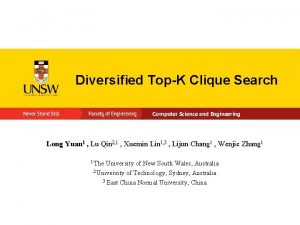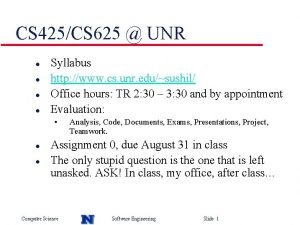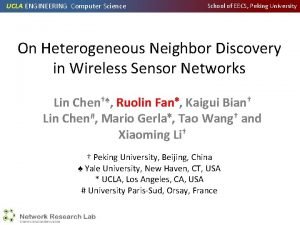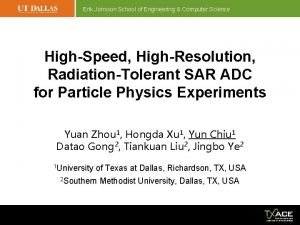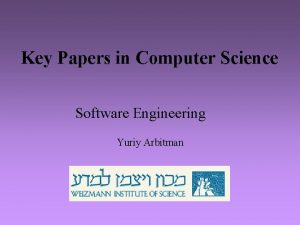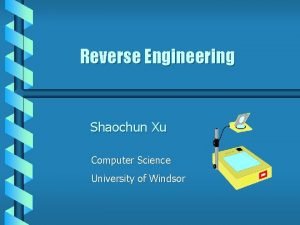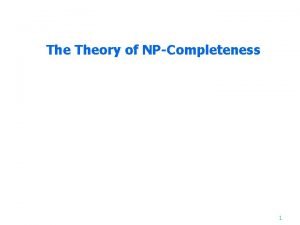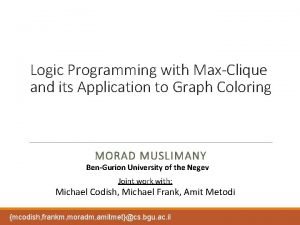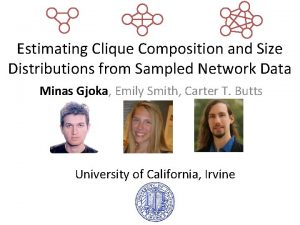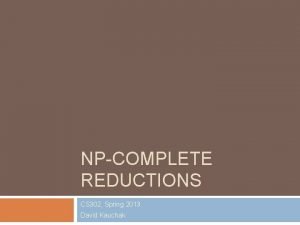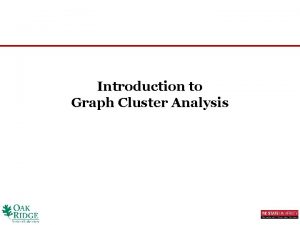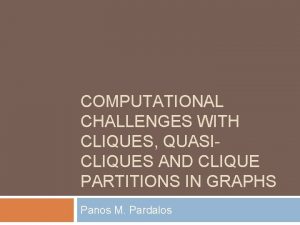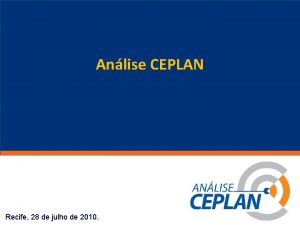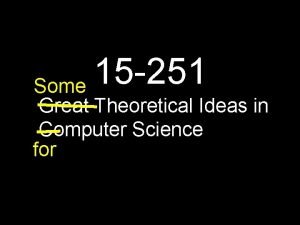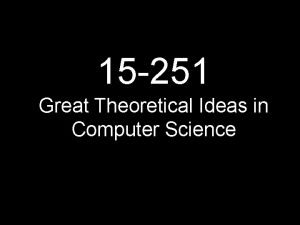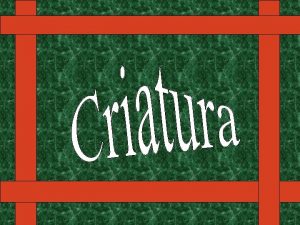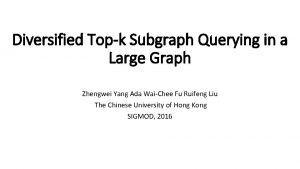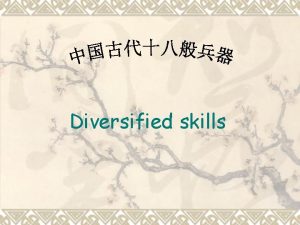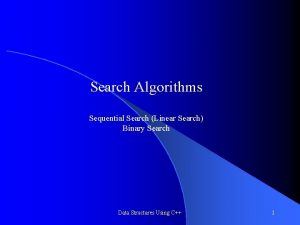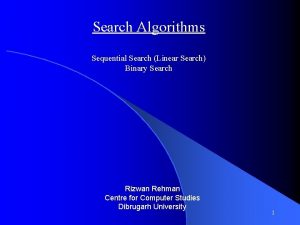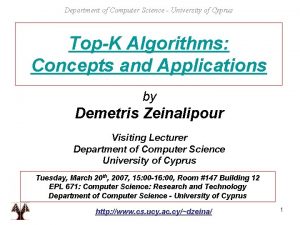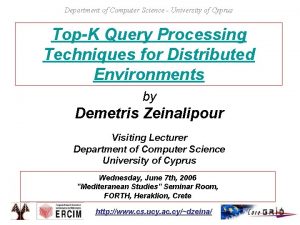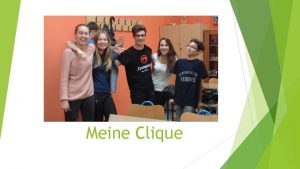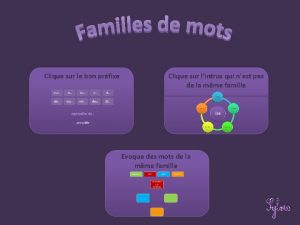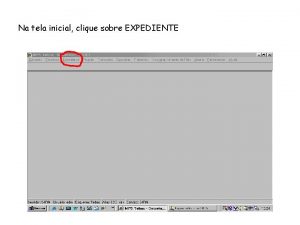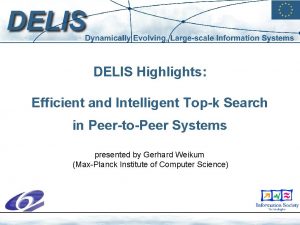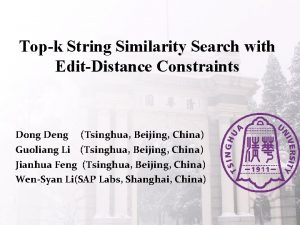Diversified TopK Clique Search Computer Science and Engineering




























- Slides: 28

Diversified Top-K Clique Search Computer Science and Engineering Long Yuan 1 , Lu Qin 2, 1 , Xuemin Lin 1, 3 , Lijun Chang 1 , Wenjie Zhang 1 1 The University of New South Wales, Australia 2 University of Technology, Sydney, Australia 3 East China Normal University, China

Outline • Diversified Top-K Clique Search • Our Approach • Experimental Study • Future Work 2

Graph Everywhere! Social Network Facebook, Twitter Web Graph Google, Yahoo Road Network The Internet of Things 3

Clique and Maximal Clique • • Given a graph G, a clique is a set of nodes such that for any pair of them have an edge A clique is called maximal clique if there exist no other bigger cliques that contain it v 6 v 1 v 8 v 4 v 0 v 5 v 2 4 v 3 v 9 v 7 v 10

Traditional models for Maximal Clique • Maximal Clique Enumeration: • Enumerate all the maximal cliques in the graph • • Exponential number of maximal cliques Large redundant and useless information • Top-K Maximal Clique: • Return top-k maximal cliques with largest size • 5 Still contain large redundancy and hold little information as a whole.

Diversified Top-K Clique v 6 v 1 v 4 v 0 v 9 v 5 v 2 6 v 8 v 3 v 10 v 7

Diversified Top-K Clique Search • Diversified Top-K Clique: • Given: a graph G and an integer k, • NP-hard Problem • Advantage: • 7 Consider both size and diversity, provide a better query result for users.

Application • Motif Discovery (X. Zheng et al. , JPP’ 11) • CEGs are represented as maximal cliques and motif discovery requires to obtain large CEGs with low overlaps. • Anomaly Detection (N. Berry et al. , AOTP’ 04) • Cliques are used as signals of rare events and the problem is to find a set of large cliques with low overlaps • Community Search (C. Lee et al. , SNMA’ 10 ) • Diversified top-k cliques can sever as the seeds for community search 8

Baseline Solutions • Enum. All Phase 1: Enumerate all the maximal cliques in the graph(D. Eppstein et al. , SEA’ 11) Phase 2: Greedily select k cliques from all the maximal cliques • Problem that cover most nodes in the graph • Clique enumeration is a costly operation • • It still outputs exponential number of maximal cliques Hard to handle large graph • without a bound Keeping all maximal cliques in memory is infeasible Enum. Sub( sample-based enumeration) • The number of cliques is exponential to the number of nodes Phase 1: Sample a subset of the maximal cliques in the graph (J. Wang et al. , KDD’ 13) Phase 2: Greedily select k cliques from the sampling that cover most nodes in the graph 9

Challenge • Retain the result quality, while avoid: 10 • generating all maximal cliques, and • keeping all generated maximal cliques in memory

Our Approach: extending online k coverage problem • Main Idea 1. online model storing k maximal cliques in memory 2. update top-k candidate set when enumerate cliques • replace small existing cliques with big new cliques – which – how Input Graph 11 Top-K Candidate Set

Replacement Strategy C 2 B C 3 A A C 1 • which one to be replaced • private set • Cmin: clique with smallest private set 12 C

Advantages of Our Approach • Guaranteed result quality • Achieve a guaranteed approximation ratio of 0. 25, and much better in practice. • Low memory consumption • Instead of all maximal cliques, just K most promising candidates are kept in memory • Efficiency and Scalability ? 13

Cost Analysis • A naïve implementation of our approach: • for each generated maximal clique C • update top-k candidate set by C with replacement condition • The time complexity is : number of maximal cliques size of maximum clique time for maintaining top-k candidate set PNP-Index 14 time for enumerating maximal cliques Pruning Rules

PNP-Index v 11 C 2 v 6 v 12 v 3 v 7 C 1 v 9 v 4 v 1 v 5 v 10 v 2 v 1 c 2 c 3 |rcov(v)| 15 v 8 v 2 v 3 v 4 C 3 v 5 v 6 v 7 v 8 v 9 v 10 v 11 v 12 |priv(C)|

PNP-Index • Step 1: Check the replacement condition C 4 v 11 C 2 v 6 v 12 v 3 v 7 C 1 v 9 v 4 v 10 v 2 v 1 c 2 c 3 |rcov(v)| c 4 16 replace C 2 with C 4 v 5 C 3 v 8 v 2 v 3 v 4 v 5 v 6 v 7 v 8 v 9 v 10 v 11 v 12 |priv(C)|

PNP-Index • Step 2: Delete C 2 v 11 C 2 v 6 v 12 v 3 v 7 C 1 v 9 v 4 v 1 v 5 v 10 v 2 v 1 c 3 |rcov(v)| 17 C 3 v 8 v 2 v 3 v 4 v 5 v 6 v 7 v 8 v 9 v 10 v 11 v 12 |priv(C)|

PNP-Index • Step 3: Insert C 4 v 11 v 6 v 12 v 3 v 7 C 1 v 9 v 4 v 1 v 5 v 10 v 2 v 1 C 3 v 8 v 2 v 3 v 4 v 5 v 6 v 7 v 8 v 9 v 10 v 11 v 12 1 1 1 c 4 c 3 |rcov(v)| 18 |priv(C)|

PNP-Index 19

Pruning Rules • Global Pruning: based on k-core and graph coloring • Local Pruning: check the current coverage of the neighbourhood • Initial Candidate Computation: increase the power of the above pruning processes 20

Experiment • Dataset 21 Dataset Type |V(G)| |E(G)| Avg Deg Google Web 875, 713 5, 105, 039 11. 66 Skitter Physical 1, 696, 415 11, 095, 298 13. 08 Youtube Social 3, 223, 589 12, 223, 774 7. 58 Pokec Social 1, 632, 803 30, 622, 564 37. 51 Wiki Reference 2, 936, 413 104, 673, 033 71. 29 UK-2002 Web 18, 520, 486 298, 113, 762 32. 19

Experiment Algorithms • Enum. All : Baseline solution 1 • Enum. Sub: Baseline solution 2 • Enum. K: Our algorithm without pruning rules Ø Local: Enum. K + local pruning Ø Global: Local + global pruning Ø Enum. KOpt: Global + Init. K Replace Enum. K by: • SOPS: Candidate maintenance using the method in (B. Saha et al. SDM’ 09) • GOPS: Candidate maintenance using the method in (Hu. Yu et al. SDM’ 13) • SIEVE: Candidate maintenance using the method in (A. Badanidiyuru et al. KDD’ 14) 22

Experiment-Efficiency Vary k 23

Experiment-Effectiveness Vary k 24

Experiment-Scalability • Generate subgraphs with 20%, 40%, 60%, 80%, 100% of nodes of two big data sets, report processing time and covered nodes Vary |V| 25

26

Future work • Disk-Based Approach • already submitted to VLDBJ • Distributed-Based Approach 27

Thank you! Questions? 28
 Clique computer science
Clique computer science Ucf college of engineering and computer science
Ucf college of engineering and computer science Erik jonsson school of engineering and computer science
Erik jonsson school of engineering and computer science Computer science and engineering unr
Computer science and engineering unr Ucla eecs
Ucla eecs Erik jonsson school of engineering and computer science
Erik jonsson school of engineering and computer science Erik jonsson school of engineering
Erik jonsson school of engineering What is system in software engineering
What is system in software engineering Why science is your favourite subject
Why science is your favourite subject Software engineering vs computer science
Software engineering vs computer science Computer science software engineering
Computer science software engineering Computer science software engineering
Computer science software engineering Reverse engineering computer science
Reverse engineering computer science Max clique problem
Max clique problem Clique clouzot
Clique clouzot The chief determinant of popularity in high school is
The chief determinant of popularity in high school is Max clique problem
Max clique problem Clique composition
Clique composition Desafio do clique
Desafio do clique Produtos de limpeza
Produtos de limpeza Som de clique
Som de clique Clique
Clique Half clique np complete
Half clique np complete Maximal clique
Maximal clique Clique
Clique Clique para editar
Clique para editar Clique para editar
Clique para editar Clique
Clique Clique
Clique
